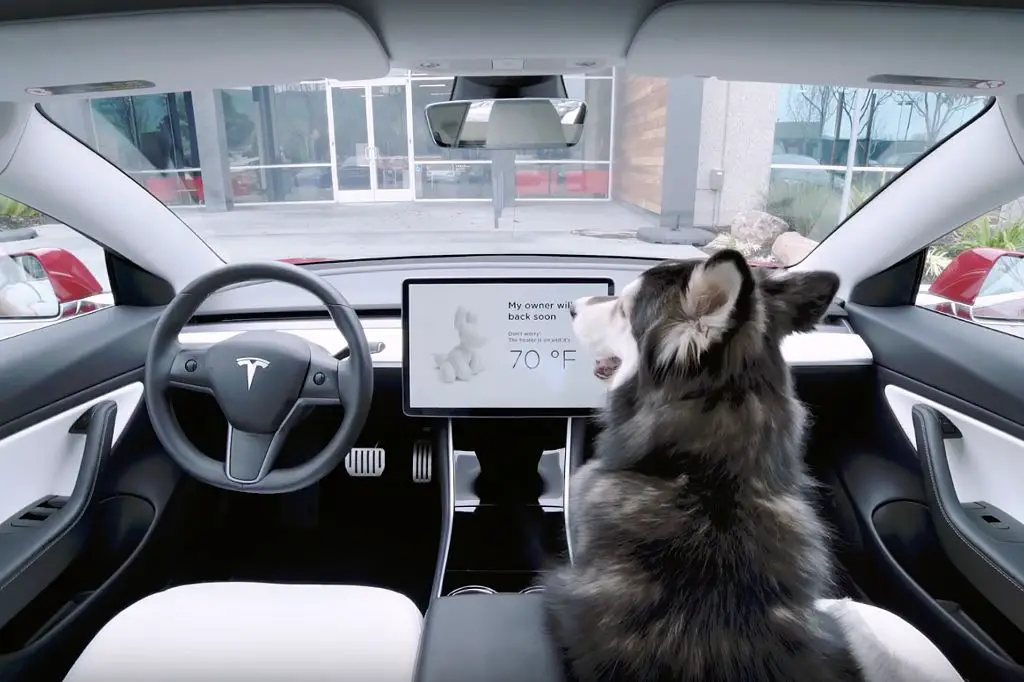What is Tesla dog mode?
Tesla’s dog mode is a feature that allows owners to keep their car’s air conditioning or heating running to maintain a comfortable temperature for pets inside, while also displaying a message on the center touchscreen to let passersby know that the animals are safe and not in danger. According to Tesla’s website, dog mode activates the climate control system to keep the temperature at or below 85°F/29°C in warm weather, and above 40°F/5°C in colder temps [1]. The message displayed reads “My owner will be back soon. Don’t worry! The A/C is on and it’s [set temperature]°F/°C.”

This feature is designed to prevent well-meaning bystanders from breaking into the vehicle to “rescue” pets that appear distressed from being left alone. The clear messaging reassures people that the animals are in a climate-controlled environment and are okay. Dog mode provides peace of mind for both the owner and the general public.
Is it legal across the US?
The legality of Tesla’s dog mode varies across the United States due to differing state and local laws. There is no federal law in the US that specifically addresses leaving pets unattended in vehicles. According to a Reddit discussion, only 11 states have laws granting citizens the legal right to use any means necessary, including smashing a window, to save a distressed dog in a hot car. However, Tesla’s dog mode is designed to maintain a comfortable temperature inside the car, monitored on the vehicle’s display screen.
While most states don’t prohibit leaving pets alone in climate-controlled vehicles, owners should check local ordinances in their area. For example, Austin, Texas bans leaving unattended animals in vehicles. Some states like Ohio place limits on the length of time pets can be left alone. California recently passed a law making it illegal to leave a dog in a car if conditions outside could cause suffering, injury or death. Overall, it’s advisable for Tesla owners to use caution and good judgement when utilizing dog mode.
State laws on leaving pets in vehicles
There are a patchwork of state laws across the United States regarding leaving pets unattended in vehicles. As of 2019, 30 states had laws making it illegal in certain circumstances [1]. Generally, these laws prohibit leaving an animal enclosed in a vehicle when conditions may endanger its health or well-being.
For example, California Vehicle Code Section 23117 states that “No person shall leave or confine an animal in any unattended motor vehicle under conditions that endanger the health or well-being of an animal due to heat, cold, lack of adequate ventilation, or lack of food or water, or other circumstances that could reasonably be expected to cause suffering, disability, or death to the animal.” Breaking this law is punishable by a fine of up to $100 per animal [2].
While the specifics vary between states, the general principle is to protect animals from extreme temperatures inside vehicles. State lawmakers have passed these laws due to concerns over heatstroke and hypothermia risks for unattended pets. The penalties for violations typically include fines, with increased penalties for repeat offenses.
Potential risks
While Tesla’s dog mode has safety features built-in, there are some potential risks pet owners should be aware of before using it. One risk is the possibility of technical malfunctions with the vehicle that could disrupt climate control and put dogs left inside at risk. Though rare, malfunctions with the battery, sensors, or HVAC system could lead to excessive heat or cold in the cabin (source).
Another potential risk is that a dog in distress may not be noticeable to people passing by the vehicle. The center touchscreen displays a message that the dog mode is on, but this may not be readable from outside. Dogs that are anxious, overheated, or having a medical emergency may not be able to get the help they need quickly enough (source).
Benefits of Tesla’s Dog Mode
One of the biggest benefits of Tesla’s Dog Mode is that it allows pet owners to keep their pets comfortable in the car while briefly stepping away. Dog Mode regulates the interior cabin temperature to remain within a safe range for dogs and other pets. This is extremely useful when an owner needs to quickly run into a store, as it ensures the pet doesn’t get overheated or too cold in the owner’s absence.

Specifically, Dog Mode uses the climate control system to maintain a temperature between 64-72° Fahrenheit. It also displays the current temperature on the center touchscreen so passersby are aware the pet is safe and not in danger. The driver can easily set and monitor the desired temperature from their Tesla app while away from the vehicle.
Overall, Dog Mode provides valuable peace of mind and convenience for owners who need to briefly leave pets behind. It allows them to run quick errands without endangering their pets’ safety in hot or cold weather conditions (1).
Tesla’s Guidance on Proper Use of Dog Mode
Tesla provides recommendations for properly using Dog Mode in its owner’s manual. The company stresses that Dog Mode is not a substitute for leaving pets at home or bringing them indoors. Tesla states that pets should never be left unattended, even with Dog Mode on.
However, Tesla does acknowledge that if you must leave your pet in the car for a short period, Dog Mode can help maintain a comfortable cabin temperature. The company recommends the following when using Dog Mode:
- Keep an eye on your pet from the mobile app and return immediately if they appear distressed.
- Avoid using Dog Mode when it’s hotter than 85°F/29°C outside.
- Set the climate control to a moderate 72°F/22°C or less.
- Only leave pets unattended for very short periods.
- Keep the key fob on you in case vehicle access is needed.

Tesla emphasizes responsible use of Dog Mode and checking local laws before using it. The company doesn’t recommend relying solely on the feature for extended periods.
Reactions
Tesla’s dog mode has received mixed reactions from law enforcement and animal rights groups. Many are unaware that the feature exists and may see a dog alone in a car on a hot day and assume the owner is negligent. This has led to some owners being wrongly accused of animal cruelty.
In one case in California, a woman noticed two dogs in a Tesla barking with the windows closed [1]. She called the police due to concern over the dogs. The responding officer saw the Tesla’s dog mode was on and the interior temperature was cool and safe. However, the owner still had to go to court and prove the dogs were not in danger before charges were dropped.
While incidents like this are rare, it highlights the need to better educate law enforcement and the public about capabilities like dog mode. Legitimate cases of pet endangerment should still be reported and investigated. But Tesla believes dog mode provides a safe way for owners to leave pets briefly if needed, as long as state laws permit it.
Notable Incidents
There have been a few high-profile cases involving Tesla’s Dog Mode feature:
In August 2019, software engineer Rahul Sood discovered a bug where Dog Mode would sometimes fail to regulate the temperature inside a Tesla vehicle. His two dogs were left in a car on a hot day and became dangerously overheated before he realized Dog Mode had malfunctioned. Tesla CEO Elon Musk acknowledged the software bug and said an update was being worked on to fix the issue.
In September 2019, a Tesla owner in the UK left his dog in Dog Mode while he quickly ducked into a store according to reports. Concerned bystanders saw the dog inside the car on a hot day and broke the window to “rescue” it, not realizing the vehicle was climate controlled. The well-meaning citizens were informed later that the car was in Dog Mode keeping the dog safe.
Alternatives for Pet Owners
While Tesla’s dog mode is a helpful feature for pet owners, there are alternatives for keeping pets comfortable and safe in vehicles without dog mode:
Many modern vehicles now come with remote start systems that allow owners to start their car and activate climate control from afar using a mobile app or keyfob [1]. This can warm up or cool down the car before the owner and pet enter. However, remote start alone does not have the same safety monitoring features of Tesla’s dog mode.

Some pet owners rig up makeshift systems to approximate dog mode using remote start and pet cameras. For example, they may remote start the vehicle to regulate the temperature, place cameras inside pointed at where the pet sits, and monitor the feed on their phone while away from the vehicle.
There are also an increasing number of aftermarket accessories focused on pet comfort and monitoring, like harnesses, built-in water bowls, and cameras. While helpful, these require advance planning and don’t offer the same seamless experience and safety assurances as purpose-built dog mode systems.
Ultimately other automakers are starting to take note of the popularity of dog mode. Ford patented a similar “Pet Mode” system in 2021 [2], and more competitors will likely follow.
The future
Dog mode technology is likely to expand to more electric vehicle makes and models in the coming years. Tesla pioneered the dog mode feature, but other automakers like Ford are now developing similar capabilities for their EVs [1]. As EVs become more mainstream, adding a dog mode will be an attractive differentiating feature.
Right now, Tesla seems to be the only automaker with a widely available production dog mode [2]. But as EV batteries become more efficient and cabin climate control systems advance, more automakers will likely have the technical capability to support reliable dog mode features. Consumer demand for the convenience and peace of mind dog mode offers will also drive adoption.
Future iterations of dog mode could include additional sensors to monitor a pet’s vital signs, cameras to check on a pet remotely, integration with smart home platforms to control climate and unlock doors, and partnerships with pet travel/hospitality brands. As the technology matures, legal considerations and safety standards will need to be addressed as well.
Within 5-10 years, dog mode or similar pet convenience features will likely shift from a novel Tesla differentiator to a standard capability found in most new EVs. Just as backup cameras went from luxury feature to mainstream expectation in under a decade, dog mode stands to see significant proliferation as EVs gain market share.
